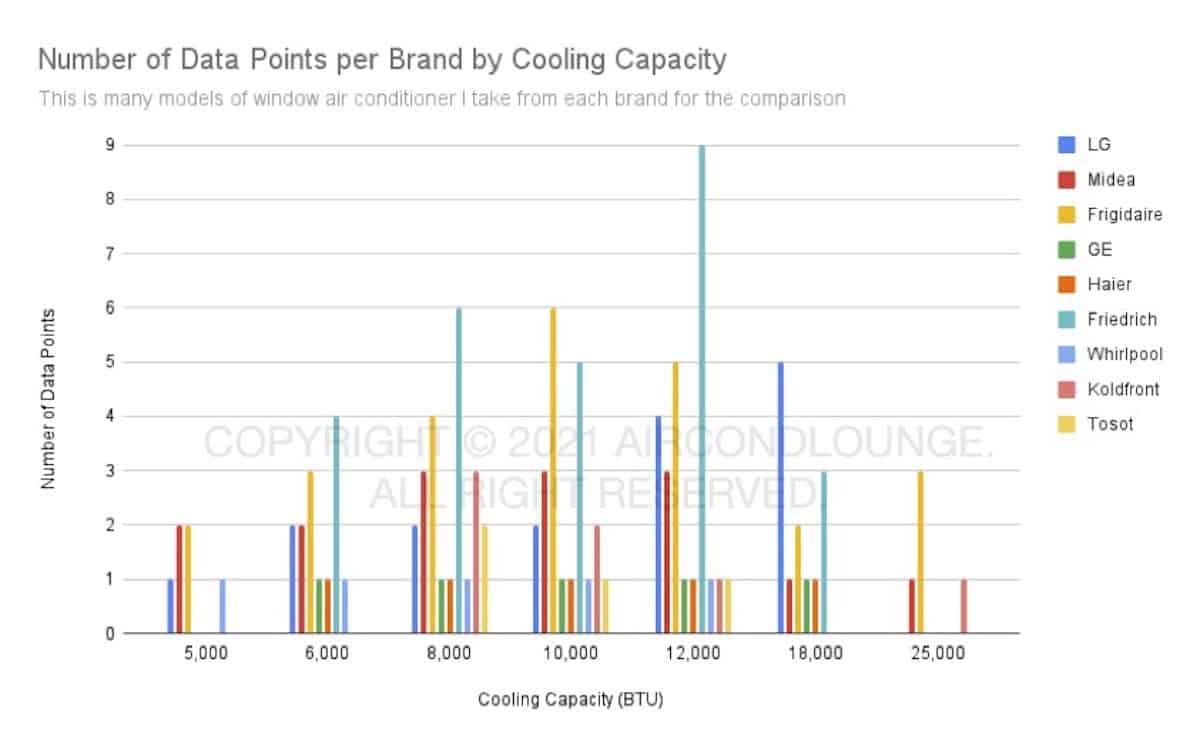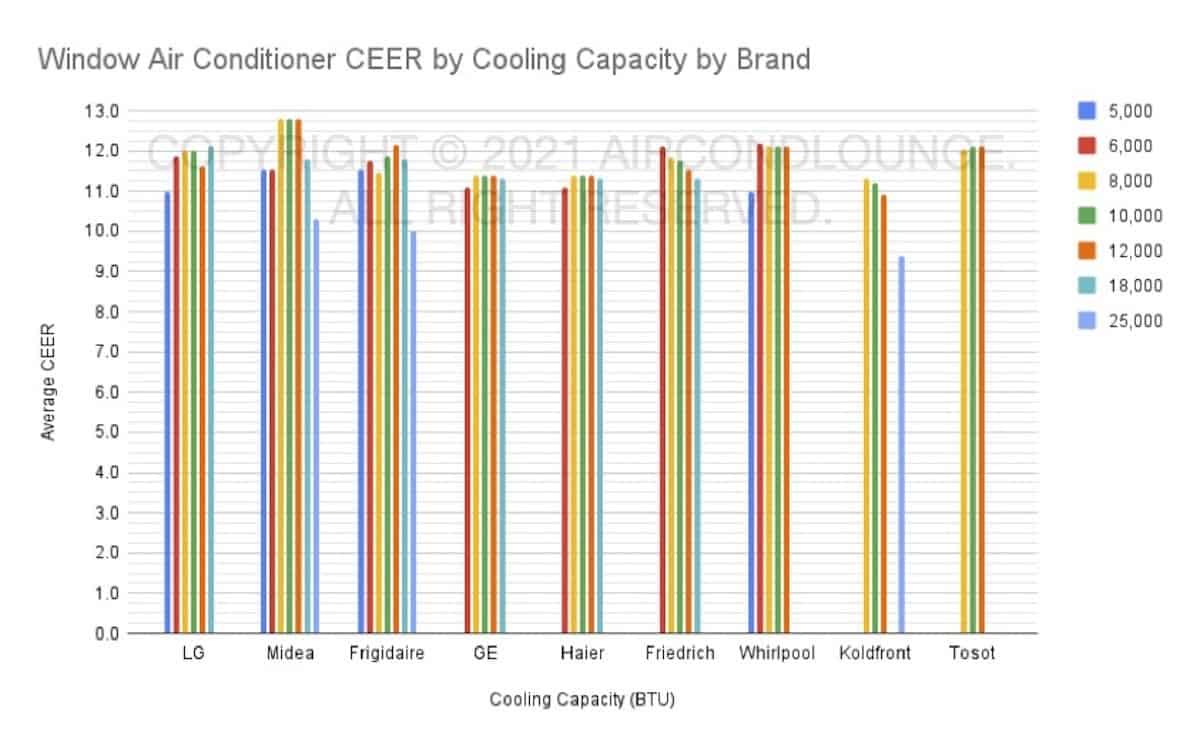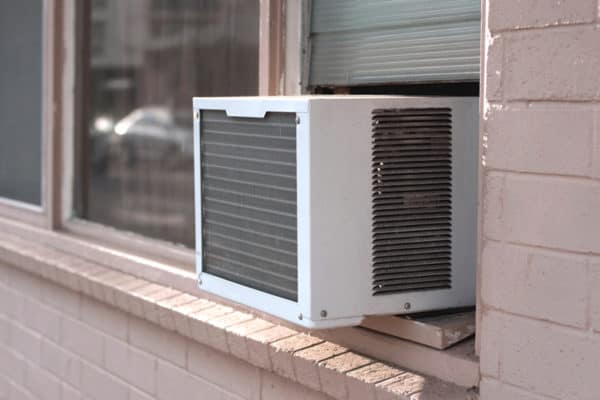Window Air Conditioner Watt: LG, Midea, Frigidaire & More
House electricity bills always shoot up during the summer. So, I gathered over 100 models of window air conditioner to find out which of them consume lesser wattage.
Generally, the higher the wattage of a window air conditioner, the more it consumes electricity. However, the actual power consumption of a window air conditioner varies according to operating conditions. For instance, if the outside temperature is high, a window air conditioner consumes more power.
Some window air conditioners use lesser wattage but they may not consume lesser electricity when we consider its overall efficiency.
How Many Watts Does a Window Air Conditioner Use?
I gathered more than 100 models of window air conditioner from 9 different brands to find out the average watts of a window air conditioner by cooling capacity.
Average Watts of a Window Air Conditioner
The wattage of a window air conditioner does not regard the voltage. I first categorize the window air conditioners by their cooling capacity. Then, I average out the wattage of all window air conditioners by cooling capacity. The below table is the resulted average watts of a window air conditioner:
| Cooling Capacity | Average Wattage |
|---|---|
| 5,000 BTU | 454 W |
| 6,000 BTU | 522 W |
| 8,000 BTU | 699 W |
| 10,000 BTU | 862 W |
| 12,000 BTU | 1,040 W |
| 18,000 BTU | 1,547 W |
| 25,000 BTU | 2,510 W |
We can be more confident on the average wattage for 6000, 8000 and 10000 BTU because these 3 categories of capacity have the most window air conditioner models. Although other categories of capacity I don’t have a similar amount of data, still there are plenty of them and they give us a fairly good estimation too.
Range of Watts of a Window Air Conditioner
A window air conditioner can consume more than 30% wattage than the other window air conditioners with the same cooling capacity but different models or brands. Thus, I thought it’s interesting to show you the range of watts of a window air conditioner by cooling capacity:
| Cooling Capacity | Wattage Range |
|---|---|
| 5,000 BTU | 410 – 537 W |
| 6,000 BTU | 480 – 700 W |
| 8,000 BTU | 660 – 910 W |
| 10,000 BTU | 820 – 961 W |
| 12,000 BTU | 990 – 1,140 W |
| 18,000 BTU | 1,490 – 1,600 W |
| 25,000 BTU | 2,140 – 2,660 W |
For the same voltage, the higher the wattage, the higher the amps and thus, a bigger size cable and breaker may be required, especially when you are dealing with a lot of high capacity window air conditioners.
Window Air Conditioner Average Watts in Heating Mode
A window air conditioner use up to 3 times the wattage when operating in heat mode compared to cool mode. When we are deciding the cable and breaker for a window air conditioner, we must use the wattage of heating mode for the equation. The below table is the average watts of a window air conditioner in heating mode:
| Cooling Capacity | Average Wattage (Heating Mode) |
|---|---|
| 8,000 BTU | 320 W |
| 10,000 BTU | 978 W |
| 12,000 BTU | 3,026 W |
| 18,000 BTU | 3,480 W |
| 25,000 BTU | 4,800 W |
Higher watts mean higher amps. Therefore, our electrical wiring must be able to cater to the higher power requirement when we need the heating.
Window Air Conditioner Wattage by Brand
So, here it comes, which brand of window air conditioner uses the least wattage? I gathered over 100 models of window air conditioner from 9 different brands to compare their wattage and present it visually as the below bar chart:

First of all, we can see that as the cooling capacity increase, the average wattage of a window air conditioner increase as well. Then, if we focus on one of the cooling capacity categories, we can compare which brand has the lowest average watts.
Take 10000 BTU as an example, at the first glance, we can see that LG and Whirlpool window air conditioners averagely use the least amount of wattage compared to other brands. However, I only have 2 models from LG and the only 1 model from Whirlpool while some of the other brands have slightly more models.
Here is how many models of window air conditioner I take from each brand for each category of cooling capacity:

From analysts’ point of view, the more the data, the better is the accuracy. However, we don’t have much choice when a manufacturer only produces one model for each category of cooling capacity.
I must highlight that I did not include odd/almost identical capacities such as 5050 BTU, 10500 BTU and 24500 BTU because they are not exactly an apple to apple comparison. I only take the exact same capacity in the effort to make my result as accurate as possible.
Furthermore, I excluded categories of cooling capacity such as 15000 BTU because there are not many models produced, too few data points available and thus, the result will not be fair.
In addition, we also can get a grasp on how many models of window air conditioners available from a brand for each category of cooling capacity from chart 2.
Identify High Wattage Window Air Conditioner Using a Rule of Thumb
From my database of over 100 models of window air conditioner, I got a pretty good multiplier for us to check if the wattage of a window air conditioner is on the high side or low side.
From 5000 BTU to 18000 BTU, a rule of thumb of 82 watts per 1,000 BTU indicates the low side of a window air conditioner watts. For instance, if a 6000 BTU window air conditioner uses 490W, we can say it uses a low wattage. On the other hand, if a 6000 BTU window air conditioner uses 535W, we can say it uses a high wattage.
For a 25000 BTU window air conditioner, you may use 96 watts per 1,000 BTU but the accuracy is questionable because I don’t have as much data as the models between 5000 BTU and 18000 BTU.
Does Higher Wattage Mean Use More Electricity?
As mentioned earlier, higher wattage generally means use more electricity. However, the wattage of window air conditioners usually represents the power consumption during cooling or heating only and we have no idea of the power consumption during standby. Thus, to compare which window air conditioners will consume lesser electricity, we must use CEER.
Efficiency of Window Air Conditioner by Brand
Combined energy efficiency ratio or CEER is a measurement of the efficiency of a window air conditioner. By measuring the cooling capacity of a window air conditioner against its power consumption during cooling and standby, we get the CEER of the window air conditioner.
“Combined Energy Efficiency Ratio (CEER) is the ratio of measured cooling output (in BTU per hour) to measured average electrical energy input (in Watts) and measured standby/off-mode power consumption (in Watts.)”
Energy Star, a government-backed symbol for energy efficiency.
I plotted the below bar chart from over 100 models of window air conditioner to compare the CEER of each brand by cooling capacity.

Generally, regardless of brand, window air conditioners with a cooling capacity of between 8000 BTU and 12000 BTU is most efficient due to averagely high CEER and thus, they consume less electricity. They mostly are above 12 CEER.
However, it doesn’t mean that we should use an 8000 BTU window air conditioner when 5000 BTU is sufficient just because of higher CEER. As we discussed earlier, the higher the cooling capacity, the more the power consumption. So, the best approach is the use the right size window air conditioner with the highest CEER.
If you have anything to add (or ask) about this topic, leave a comment down below!




